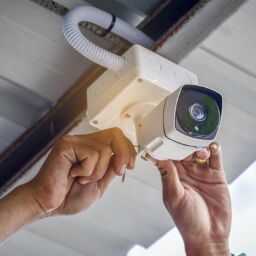When you get ready to purchase, take the opportunity to read the guarantees and disclaimers on the supplier’s website. Also read the frequently asked questions (FAQs) on their website and any customer reviews. Finally if the retailer hesitates or refuses to disclose any information, consider that a red flag. However if you email or via telephone ask a technical question and the retailer asks for time to consult their supplier, that can be considered a good thing. It means they are not just giving answers, any answers, to make the sale.
For the home or small business, installing a video surveillance system should be a Do-it-Yourself project. You can save a lot of money and earn a wealth of knowledge about your system, if you install it yourself. These systems today are basically place and plug-in systems. They run off of standard 115 volt electricity from a standard wall plug. For Internet capability, all you need is a standard modem to plug into.
Almost all video surveillance system cameras today have 15 frames per second (fps) or more. You can get by with 7 to 8 fps, for home security use, but you get a really clear picture at 15 fps. Casinos and the police use cameras that have 30 fps, so that they can see extreme detail, especially when enlarging a frame for recognition or detail. You really don’t want to over buy your equipment and spend too much money. A pan, tilt and zoom camera (PTZ camera) or High Speed Dome Camera can record at a high frame rate, but can cost $1,200 to $1,700 per camera. These are usually used outdoors on a building where lighting may not be controlled and being able to read a license plate may be the objective.
For home or small business use you either will not recognize the intruder, even if you use a camera with 30 fps or you will know exactly who it is with a camera at 8 fps. Let the police take care of criminals you don’t know and they can use software to enhance your videos. In the other instance, if you recognize the intruder, it is probably an employee, neighbor or friend. Once you confront them and show them your video, you won’t need to use expensive equipment to prove they were there. So I encourage you to not spend more money than you need to for higher frames per second.
An IR camera or infrared cameras can see in very low lighting. They do this by using LEDs that create the infrared lighting that the camera can see. One problem is the LEDs usually last between 2 to 3 years and they are integrated into the camera, effectively shortening the camera life to 2 to 3 years. An alternative is an infrared illuminator that can be used with one or more cameras. When the diodes fail in the illuminator, you just replace the illuminator. A better alternative is motion-activated flood lights or spotlights that will not only give you sufficient lighting for your camera, but adds to a safer environment for you, your family or your employees.
Color cameras are an option, an option that you might want, but do not have to have to have an effective system. In low light situations, color cameras are not as effective. Under these conditions the black and white camera will get better resolution. There are cameras available today that operate as a color camera in normal lighting and then a black and white camera in reduced lighting. There’s nothing wrong with color, but you will pay more.
The camera feeds video information to a security DVR or digital video recorder (DVR) and the DVR turns that into digital information for sending to your monitor or the Internet. The DVR also records the information on a hard drive that is internal to the DVR. Most DVR’s are in the same price range, the only difference being the number of cameras or channels it can operate. If you buy a 4 camera security DVR and expand later find you need 8 cameras than you will need to buy another DVR. However before you buy an eight channel DVR consider the location and possible power failures. Any piece of equipment or source of power can fail, rendering your equipment useless. Maybe you need two DVR’s of four channels each in different locations running off of different circuit breakers or in different buildings. Also consolidating a DVR and four cameras in one area may save on physical wire or keep the cameras in range for wireless set-ups. You can network the DVR’s by plugging into any network connection to take it back to the modem, or the security monitoring area. One other consideration would be supplying the DVR with a UPS power supply so it doesn’t have to be reset in case of power failure.
Stand-alone DVR’s used to have hard drives with a capacity of 30 gigabytes or about 30 hours of black and white recording. Today 500 gigabytes is considered ample for home or small businesses that are monitoring from overnight to 3 days of recording. The larger the hard drive the more money you will spend. Having motion activated cameras will save recording time and only record when an intruder is present. The motion activation is a function of the DVR by interpreting the video data from the camera.
You will think your situation is unique and you need special equipment to supply your video surveillance needs, and maybe you do. However you will find many things are standard; so standard that in most cases buying a complete DVR system package is the best deal and the most affordable. Cameras can be purchased separately and so can other components of the system. A wired system can be turned into a wireless system or vice-versa.



